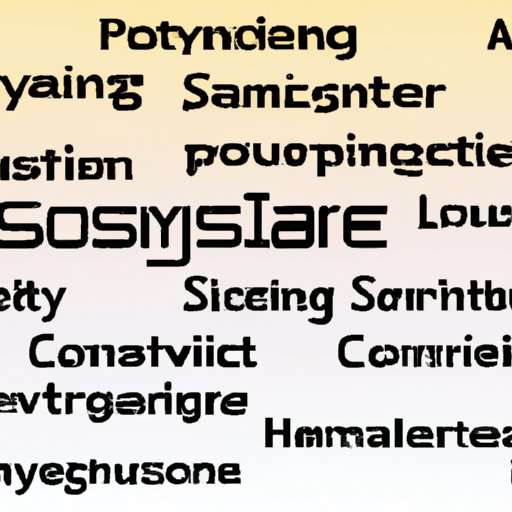Introduction
Cybersecurity is the practice of protecting networks, systems, and programs from digital attacks. These attacks are usually aimed at accessing, changing, or destroying sensitive information, extorting money from users, or interrupting normal business processes. To combat these threats, organizations need to employ professionals with expertise in coding, cryptography, and other computer technologies. In this article, we will explore the programming languages used in cybersecurity and how they help protect networks and systems.

A Comprehensive Guide to Programming Languages Used in Cybersecurity
The programming languages used in cybersecurity can be divided into two categories: general-purpose languages and domain-specific languages. General-purpose languages, such as C++ and Java, are used for developing applications and software. Domain-specific languages are designed for specific tasks and are typically used for security-related projects. The most commonly used programming languages for cybersecurity are Python, C/C++, Java, JavaScript, and Assembly.
Exploring the Top Programming Languages for Cybersecurity Professionals
Python is one of the most popular programming languages used in cybersecurity. It is a high-level, interpreted language that is easy to learn and use. Python is often used for scripting, automation, and developing security tools. According to a study by the SANS Institute, “Python is the de facto language for security operations and analysis.”
C/C++ is another popular language used in cybersecurity. It is an object-oriented language that is fast and flexible. C/C++ is used for developing operating systems, computer games, and embedded systems. It is also used for developing security tools, such as antivirus and anti-malware programs.
Java is a cross-platform, object-oriented language that is widely used in cybersecurity. It is used for developing web and mobile applications, as well as for creating secure software and applications. Java is also used for developing malware and ransomware detection systems.
JavaScript is a scripting language that is used for developing interactive webpages and applications. It is often used for building secure web applications, such as banking websites. JavaScript is also used for developing automated testing tools and security scanners.
Assembly is a low-level language that is used for developing system-level software and hardware. It is used for writing malware and viruses, as well as for creating reverse engineering tools and security tools. According to a survey conducted by the Ponemon Institute, “assembly language is the most commonly used language for creating malicious code.”

A Breakdown of the Different Programming Languages Used in Cybersecurity
The programming languages used in cybersecurity can be broken down into three main categories: scripting languages, object-oriented languages, and assembly languages. Scripting languages, such as Python, JavaScript, and Perl, are high-level languages that are used for automating tasks and developing security tools. Object-oriented languages, such as C++ and Java, are used for developing secure applications and software. Assembly languages, such as x86 and ARM, are low-level languages that are used for developing system-level software and hardware.

An Overview of the Most Popular Programming Languages for Cybersecurity Applications
Python is one of the most popular programming languages used in cybersecurity. It is an interpreted, high-level language that is easy to learn and use. Python is used for scripting, automation, and developing security tools. It is also used for developing malware and ransomware detection systems.
C/C++ is a powerful, object-oriented language that is used for developing secure applications and software. It is also used for developing operating systems, computer games, and embedded systems. C/C++ is used for creating antivirus and anti-malware programs, as well as for developing reverse engineering tools.
Java is a cross-platform language that is used for developing web and mobile applications. It is also used for creating secure software and applications. Java is used for developing malware and ransomware detection systems, as well as for creating automated testing tools and security scanners.
JavaScript is a scripting language that is used for developing interactive webpages and applications. It is often used for building secure web applications, such as banking websites. JavaScript is also used for developing automated testing tools and security scanners.
Assembly is a low-level language that is used for developing system-level software and hardware. It is used for writing malware and viruses, as well as for creating reverse engineering tools and security tools. Assembly is the most commonly used language for creating malicious code.
How Specific Programming Languages Help Secure Networks and Systems
Python is a versatile language that is used for scripting, automation, and developing security tools. It is often used for developing malware and ransomware detection systems, as well as for creating automated testing tools and security scanners. Python is also used for developing secure web applications and for encrypting data.
C/C++ is a powerful language that is used for developing secure applications and software. It is used for creating antivirus and anti-malware programs, as well as for developing reverse engineering tools. C/C++ is also used for developing embedded systems and for encrypting data.
Java is a cross-platform language that is used for developing web and mobile applications. It is also used for creating secure software and applications. Java is used for developing malware and ransomware detection systems, as well as for creating automated testing tools and security scanners.
JavaScript is a scripting language that is used for developing interactive webpages and applications. It is often used for building secure web applications, such as banking websites. JavaScript is also used for developing automated testing tools and security scanners.
Assembly is a low-level language that is used for developing system-level software and hardware. It is used for writing malware and viruses, as well as for creating reverse engineering tools and security tools. Assembly is the most commonly used language for creating malicious code.

The Benefits and Limitations of Programming Languages in Cybersecurity
The programming languages used in cybersecurity have many benefits. They are versatile and can be used for a variety of tasks, such as scripting, automation, and developing security tools. They are also powerful and can be used for creating secure applications and software. Additionally, they are fast and efficient and can be used for encrypting data.
However, there are some limitations to the programming languages used in cybersecurity. They can be difficult to learn and require a lot of coding knowledge. Additionally, they are not always compatible with all platforms and operating systems. Finally, they can be vulnerable to attacks if not properly implemented.
Comparing the Different Programming Languages Used in Cybersecurity Projects
There are several factors to consider when comparing the different programming languages used in cybersecurity. One factor is speed and efficiency. Python and JavaScript are both fast and efficient, while C/C++ and Java are slower but more powerful. Another factor is compatibility. Python and JavaScript are cross-platform languages, while C/C++ and Java are platform-specific. Finally, there is ease of use. Python and JavaScript are easier to learn than C/C++ and Java.
Advantages and Disadvantages of Each Language
Each programming language has its own advantages and disadvantages. Python is a versatile language that is easy to learn and use. However, it is not always compatible with all platforms and operating systems. C/C++ is a powerful language that is fast and efficient. However, it is difficult to learn and requires a lot of coding knowledge. Java is a cross-platform language that is used for developing secure applications and software. However, it can be vulnerable to attacks if not properly implemented. JavaScript is a scripting language that is used for developing interactive webpages and applications. However, it is not as powerful as other languages.
Conclusion
In conclusion, there are several programming languages used in cybersecurity. These include Python, C/C++, Java, JavaScript, and Assembly. Each language has its own advantages and disadvantages. Python is a versatile language that is easy to learn and use, while C/C++ is a powerful language that is fast and efficient. Java is a cross-platform language that is used for developing secure applications and software, and JavaScript is a scripting language that is used for developing interactive webpages and applications. Assembly is a low-level language that is used for developing system-level software and hardware.
Overall, the programming languages used in cybersecurity can be used to create secure networks and systems. They can also be used for developing malware and viruses, as well as for creating automated testing tools and security scanners. However, they can be difficult to learn and require a lot of coding knowledge. Additionally, they can be vulnerable to attacks if not properly implemented.
Summary of Key Points
In this article, we explored the programming languages used in cybersecurity. We discussed the top programming languages, such as Python, C/C++, Java, JavaScript, and Assembly, and we broke down the different types of languages. We also discussed the advantages and disadvantages of each language and how they help secure networks and systems. Finally, we compared the different programming languages used in cybersecurity projects.
Final Thoughts on Programming Languages Used in Cybersecurity
The programming languages used in cybersecurity are essential for creating secure networks and systems. They are versatile and can be used for a variety of tasks, such as scripting, automation, and developing security tools. They are also powerful and can be used for creating secure applications and software. However, they can be difficult to learn and require a lot of coding knowledge. Additionally, they can be vulnerable to attacks if not properly implemented.
(Note: Is this article not meeting your expectations? Do you have knowledge or insights to share? Unlock new opportunities and expand your reach by joining our authors team. Click Registration to join us and share your expertise with our readers.)
